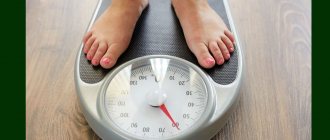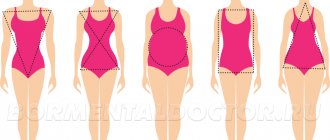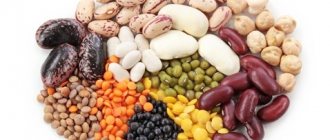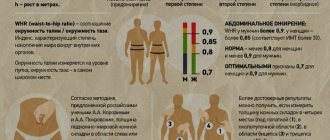For example, with the same weight and height, one person may look normal while another is overweight.
Therefore, excess fat in the body is assessed not only by the given formulas, but also by the thickness of the skin folds and simply by appearance.
Is there an ideal height and weight for a girl?
Until recently, the recognized standard of beauty was an almost boyish figure, with no room for anything “extra.” Today you can often come across heated debates about the ideal figure and the ideal weight; as a rule, these are two opposing camps, the participants of which are ready to debate for a long time about what a modern representative of the fairer sex should look like, what is the ideal weight for a girl. Some argue that it is necessary to “hang out” in the gym all day long and carefully count all the calories that enter the body during the day. Others are trying to prove the opposite point of view is correct - that you shouldn’t torture your body with workouts and strict diets, you can calmly eat whatever you want and not abuse your body on the treadmill. As always, the truth is somewhere in the middle; the ideal weight for a woman is her natural weight. And in order to find out the treasured figure, it is important to take into account many other factors, and not just the value touched by the scale arrow. It is necessary to take into account height, age, body type, as well as body volumes and proportions.
Today, there is more than one formula by which women in different countries calculate their ideal weight. But the calculations obtained using these formulas do not mean that this ideal weight for your height for girls should be the only correct one. The information that you will see in the table of ideal weight for girls is more of an informational and advisory nature. Only a personal nutritionist can provide the most complete information, who will know not only your obvious data (height, volume, age, proportions), but also individual characteristics and diseases. After all, a lot depends on them too.
Explanations of the results
The results of BMI calculations are not suitable for estimating the weight of professional athletes, pregnant women, as well as people suffering from edema and other disorders that lead to an incorrect assessment of the initial data.
The weight ranges in this calculator are calculated taking into account height, according to the methods of the World Health Organization (WHO).
The method of assessing weight using BMI is intended for the primary identification of underweight or excess weight. Receiving a score different from the norm is a reason to contact a nutritionist and endocrinologist in order to conduct an individual weight assessment and develop recommendations for its correction, if necessary.
The ideal weight range (normal) shows at what weight the probability of occurrence and recurrence of diseases associated with overweight or underweight is minimal. In addition, as practice shows, a person with a normal weight looks not only healthy, but also the most attractive. If you are adjusting your weight, it is highly recommended not to go beyond the norm in order to avoid health problems.
Ideal weight table for girls
The most famous way to calculate ideal weight is the formula of the French anthropologist Broca, which is relevant for people above 155 and below 185 centimeters. This formula for calculating ideal weight and height has been used since the 19th century. You need to find out your height, and then subtract 100 if your height is less than 165 centimeters. If a girl’s height is up to 175 centimeters, then 105 must be subtracted from her height. If a girl is lucky enough to be born tall, and her height exceeds 175 centimeters, 110 must be subtracted from it.
However, this is not the end of the calculations of the ideal weight for your height for a girl. When calculating, it is necessary to take into account your body type. It is calculated by the circumference of the wrist.
If the wrist circumference is less than 15 centimeters, this is an asthenic girl. A hand circumference of 15 to 18 centimeters is usually characteristic of normosthenics. The wrist circumference is from 18 centimeters for hypersthenics. For asthenics, the number obtained from “subtracting” growth should be reduced by 10%. This will be the “ideal” weight. Hypersthenics need to add 10%. And for normosthenics, additional calculations are not required.
To make it clearer, let's look at specific examples. The ideal weight for a height of 165 for a normosthenic girl can be found by simply subtracting 100 from 165 - in the end we get 65 kilograms.
Methods for Calculating Body Fat Ratio
The objective parameter of an ideal body is the percentage of fat and musculoskeletal tissue. For men, the norm is 9–15% fat of total body weight, and for women – from 12 to 20%.
Method 1. Quetelet index
If you know your body mass index, you can judge whether you are obese or underweight. The index is calculated for adult men and women from 20 to 65 years old. Results may be false for pregnant and breastfeeding women, athletes, the elderly and adolescents (under 18 years of age).
How to count? Square your height in meters, then divide your body weight in kilograms by the resulting figure. For example: height 170 cm, weight 65 kg. So 65: (1.7 * 1.7) = 22.5.
The resulting number will be your index. The norm for men is 19-25. For women - 19-24.
| Classification | Body mass index, kg/m2 (BMI according to Ketler) | Risk of comorbidities |
| Underweight | less than 18.5 | Low (increased risk of other diseases) |
| Normal body weight | 18,5-24,9 | Ordinary |
| Excess body weight (pre-obesity) | 25,0-29,9 | Elevated |
| Obesity I degree | 30,0-34,9 | High |
| Obesity II degree | 35,0-39,9 | Very tall |
| Obesity III degree | 40.0 or more | Extremely high |
Method 2. Volumes
The Quetelet index shows the amount of fat in the body quite well, but does not indicate how the fat is distributed, in other words, it does not give a visual picture. But you can check your body for ideality using another formula.
The distribution of body fat is determined by the ratio: waist circumference (at the level of the navel) divided by the volume of the buttocks. The norm for men is 0.85; for women - 0.65 - 0.85.
Method 3. Taking into account age
It has been proven that the weight of men and women should gradually increase with age - this is a normal physiological process. The kilograms that some people consider “extra” may not actually be so. You can use a formula based on age to determine your optimal weight.
P is height in this case, and B is age in years. Body weight = 50 + 0.75 (P - 150) + (B - 20) : 4
Method 4. Broca's formula
One of the most popular methods for calculating ideal weight is Brock's formula. It takes into account the ratio of height, weight, body type and age of a person.
Broca's formula for people under 40 years old: height (in cm) minus 110, after 40 years - height (in cm) minus 100.
In this case, people who have an asthenic (thin-boned) body type must subtract 10% from the result, and people who have a hypersthenic (broad-boned) body type must add 10% to the result.
How to determine your body type? It is enough to measure the circumference of the thinnest place on the wrist with a centimeter.
| Body type | Solovyov index - for men | Solovyov index - for women | Typical for this body type |
| normosthenic (normal) | 18-20 cm | 15-17 cm | the physique is distinguished by the proportionality of the main dimensions and their correct ratio |
| hypersthenic (wide-boned) | more than 20 cm | more than 17 cm | In people with a hypersthenic (broad-boned) body type, the transverse dimensions of the body are much larger than in normosthenics and especially asthenics. Their bones are thick and heavy, their shoulders, chest and hips are wide, and their legs are short. |
| asthenic (thin-boned) | less than 18 cm | less than 15 cm | In people with an asthenic (thin-boned) body type, longitudinal dimensions prevail over transverse ones: long limbs, thin bones, long, thin neck, muscles are poorly developed. |
Method 5. Nagler's formula
There is a Nagler formula that allows you to calculate the ideal ratio of weight and height. For 152.4 cm of height there should be 45 kg of weight. For every inch (that is, 2.54 cm) over 152.4 cm there should be another 900 g. Plus another 10% of the resulting weight.
Method 6. John McCallum formula
One of the best formulas was created by expert methodologist John McCallum. Its formula is based on measuring the circumference of the wrist.
- Wrist circumference multiplied by 6.5 is equal to chest circumference.
- 85% of the chest circumference is equal to the hip circumference.
- To get your waist circumference, you need to take 70% of your chest circumference.
- 53% of the chest circumference is equal to the hip circumference.
- For the neck circumference you need to take 37% of the chest circumference.
- The biceps is about 36% of the chest circumference.
- The girth for the lower leg is slightly less than 34%.
- The forearm circumference should be equal to 29% of the chest circumference.
But not everyone’s physical data will exactly correspond to these ratios; the numbers have an average, statistical average value.

A few more options for height and weight ratios:
- The physique is considered ideal if the waist circumference is 25 cm less than the hip circumference, and the hip circumference is approximately equal to the chest circumference.
- The waist circumference should be equal to: height in centimeters - 100. That is, a woman 172 cm tall will be built proportionally if the waist circumference is 72 cm, the hip and chest circumference is about 97 cm, that is, if she wears clothing size 48.
- If the hip circumference is less than the chest circumference, and the waist circumference is 20 cm less than the hip circumference, then this figure is called an “apple”. If the chest circumference is less than the hip circumference, and the waist circumference is 30 cm or more less than the hip circumference, this is a pear-shaped figure.
- For women and girls of average height - from 165 to 175 cm - this observation turned out to be fair. Their waist circumference in centimeters is approximately equal to their weight in kilograms. One kilogram of weight loss results in a decrease in waist size of one centimeter.
Knowing the ratio of weight and height, it is easier to regulate nutrition and training rates.
Psychological reasons can also contribute to obesity.
Based on materials from Kuzma
Tags: How to lose weight
- Related Posts
- Lose weight for the New Year: quickly and easily!
- Overweight – Lose weight without harm with HuaShen products
- Getting your figure ready for summer
« Previous entry
Ideal weight for your age for girls
A person's weight increases with age, and this is considered normal. Of course, its increase should be “within what is permitted” and not be too sharp, strong and critical for a person’s appearance and lifestyle. A woman may feel that her weight is higher than normal, but at the same time it will be within the normal range for her age. To calculate ideal weight based on age, use the following formula: 50 + 0.75 (P-150) + (B-20) /4
In this formula, P is a person’s height, and B is his age. For example, for a girl 27 years old and 170 cm tall, judging by this formula, the ideal weight would be 66.75 kg. 50 + 0.75 (20) + (7) /4 = 66.75
Also, what is the ideal weight for a girl with a height of 150, 160, 165, 170 cm and above, the corresponding table, which is also focused on the person’s age, will help you find out.
| Height, cm | Age | |||||
| 20-29 | 30-39 | 40-49 | 50-58 | 59-75 | ||
| 150 | 48,9 | 53,9 | 58,5 | 55,7 | 54,8 | |
| 152 | 51 | 55 | 59,5 | 57,6 | 55,9 | |
| 154 | 53 | 59,1 | 62,4 | 60,2 | 59 | |
| 156 | 55,8 | 62 | 66 | 63 | 59 | |
| 158 | 58 | 64 | 68 | 64 | 62 | |
| 160 | 59 | 66 | 69 | 66 | 65 | |
| 162 | 62 | 69 | 73 | 69 | 66 | |
| 164 | 63,7 | 70,8 | 74 | 72 | 70 | |
| 166 | 65,2 | 71.8 | 77 | 74 | 71,4 | |
| 168 | 68,5 | 74 | 78,2 | 74,8 | 73,3 | |
| 170 | 70 | 75,8 | 78 | 76,8 | 75 | |
| 172 | 73 | 77 | 81,7 | 77,7 | 76,3 | |
| 174 | 74,3 | 79 | 84 | 79,4 | 78 | |
| 176 | 77 | 80 | 84,7 | 80,5 | 79,1 | |
| 178 | 78,2 | 82,4 | 87 | 82,4 | 81 | |
| 180 | 81 | 83,9 | 88 | 84,1 | 81,7 | |
| 182 | 83,5 | 87,7 | 89,3 | 86,7 | 83 | |
| 184 | 85,5 | 89,4 | 91 | 87,4 | 85,8 | |
| 186 | 89,2 | 91 | 94 | 89,7 | 87,4 | |
| 188 | 92 | 94,4 | 95,8 | 91,5 | 88,8 | |
| 190 | 92,3 | 95,8 | 97,4 | 95,7 | 92 | |
Calculation of weight by height and age
Electronic floor scales will help determine the most accurate weighing result. If you have not yet acquired this necessary attribute for weighing or want to replace your scales with more modern and accurate ones. On the website you will find not only a huge assortment of floor scales, but you will also be able to choose the most attractive price for yourself.
For quite a long time, Brock’s weight formula was popular, which helped calculate the expected weight-height ratio using the following system: height in centimeters minus 100 equals ideal weight .
However, recently these indicators have been revised and it is believed that this formula is more suitable for determining weight by age of women 40-50 years old.
Women 20-30 years old should weigh 10-12% less than this figure, and after the age of 50 the weight increases by 5-7%.
This is the easiest way to find out your ideal weight by height and age. Today, other formulas and tables that take into account body type are more often used.
To calculate the best body fat ratio, you need to calculate the percentage of fat and musculoskeletal tissue. For men, the norm is 9 - 15% fat of total body weight, for women the norm is 12 - 20%.
Useful recommendation! To effectively and safely lose excess weight, use natural organic weight loss complexes from iHerb. Numerous reviews for each herbal preparation will help you choose the most suitable system for yourself.
One of the popular ways to determine height and weight is the Quetelet index or body mass index (BMI). This index helps assess how underweight or obese a person is; it is a good indicator of the amount of fat in the body, but does not indicate how this fat is distributed in the body.
Quetelet's body mass index may be inaccurate for adolescents, older adults, pregnant and lactating women, and athletes. Most often, this index is used for adult men and women from 20 to 65 years old.
Weight calculation formula
Formula: body weight in kg divided by height in meters squared B/(P*P). For example: height 180 cm, weight 75 kg. So 75: (1.8 * 1.8) = 23.1
At the same time, the normal indicator for men is 19-25, for women - 19-24. Indicators from 25 to 29.9 indicate overweight. 30 - 39.9 – for obesity with a moderate risk of complications (II). A score above 40 indicates obesity with a high risk of complications (grade III).
| Body mass index | Classification | Risk of comorbidities |
| Less than 18.5 | Underweight | Low (increased risk of other diseases) |
| 18,5 — 24,9 | Normal weight | Ordinary |
| 25,0 — 29,9 | Excess weight | Elevated |
| 30,0 — 34,9 | Obesity I degree | High |
| 35,0 — 39,9 | Obesity II degree | Very tall |
| 40.0 or more | Obesity III degree | Extremely high |
Let's look at another formula to help check the distribution of body fat:
The waist circumference at the navel level should be divided by the volume of the buttocks.
For example: waist 70 cm, hips 105. This means 70: 105 = 0.66. The norm for men is 0.85. For women - 0.65 - 0.85.
Broca's formula.
The formula for determining ideal weight was developed in 1871 by the French surgeon and anthropologist Paul Broca, it is designed for people above 155 and below 185 centimeters, of average build. This is a refined definition for his first known formula (growth minus 100):
Broca's index, for women:
| Ideal weight = (Height - 100) * 0.85 |
Broca's index, for men:
| Ideal weight = (Height - 100) * 0.9 |
Task: Calculate the ideal weight for men 185 centimeters.
Ideal weight = (180 - 100) * 0.9 = 72 kg This formula is calculated for a woman 165 centimeters tall. Ideal weight = (165 - 100) * 0.85 = 55.25 kg
WEIGHT AND COOKING
There is another area of human activity that requires strict measurement of the mass of the components used. We are talking about the magical world of creating culinary masterpieces. It is only at first glance that it seems that the chefs conjure their creations by eye and taste. They tried the dish on the go, and everything immediately became clear to them: add salt or add seasonings. In reality, everything is different. Some types of food products require the strictest dosage of ingredients. This is especially true for sweet products - colorful cakes, small charming pastries, airy desserts and other capricious confectionery products. Bakery products are also capricious in production; an overdose of yeast or sugar easily leads to the fact that the dough does not want to rise, and the finished buns will have cracks and tears. Experienced chefs know for sure that a true culinary masterpiece is obtained only by strictly following the recipe, and the nuances of the behavior of the raw materials must also be taken into account.











